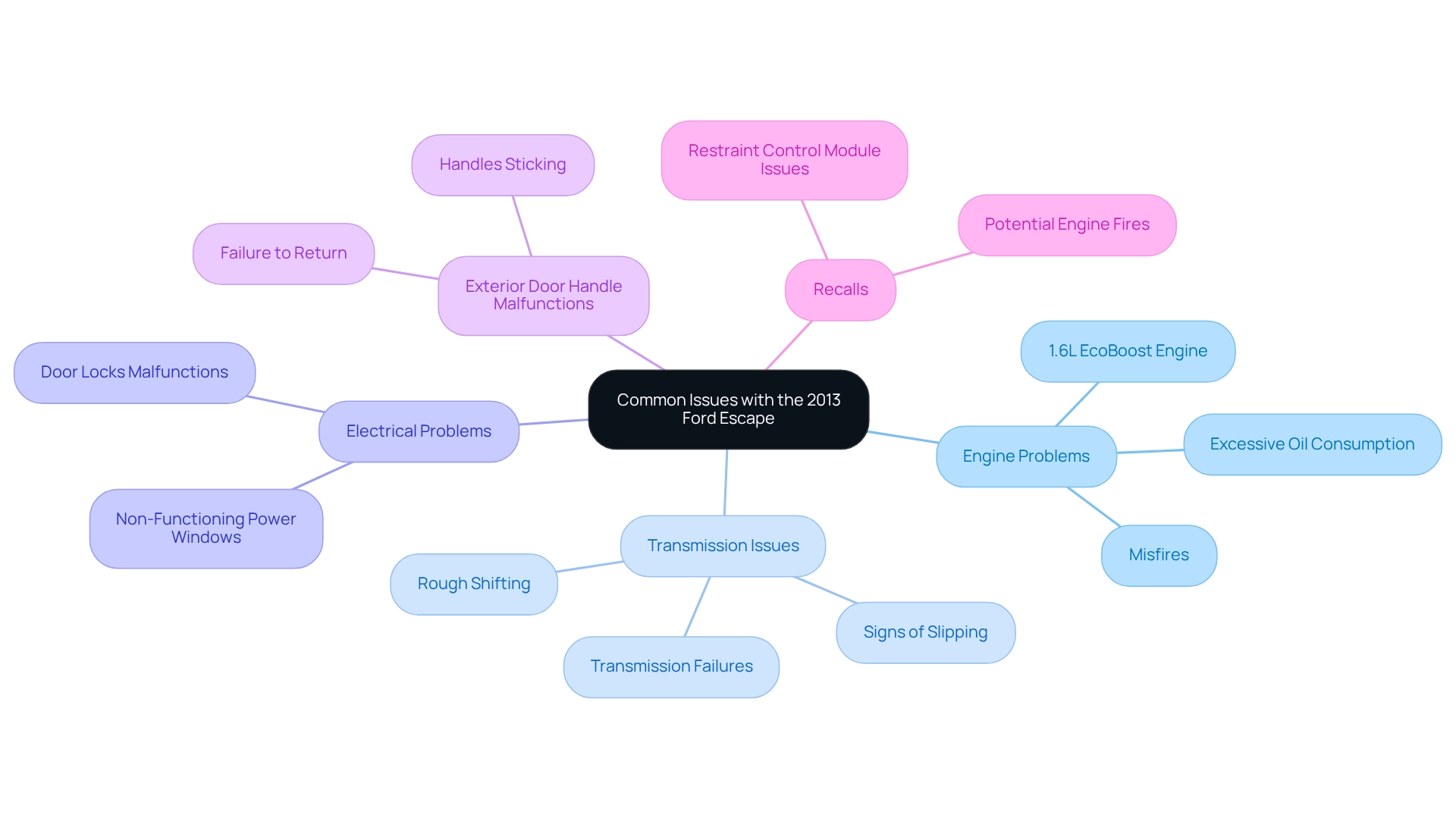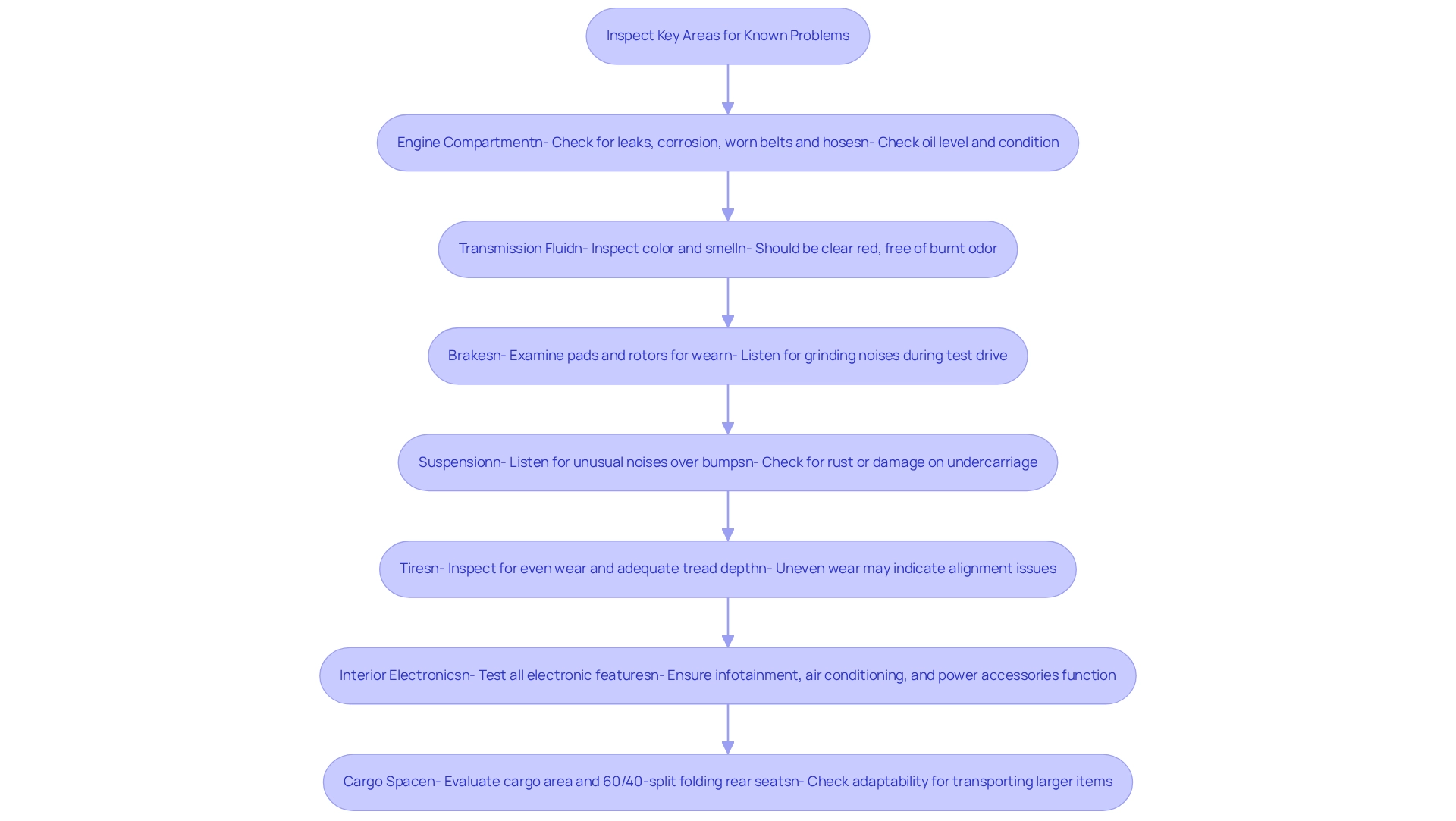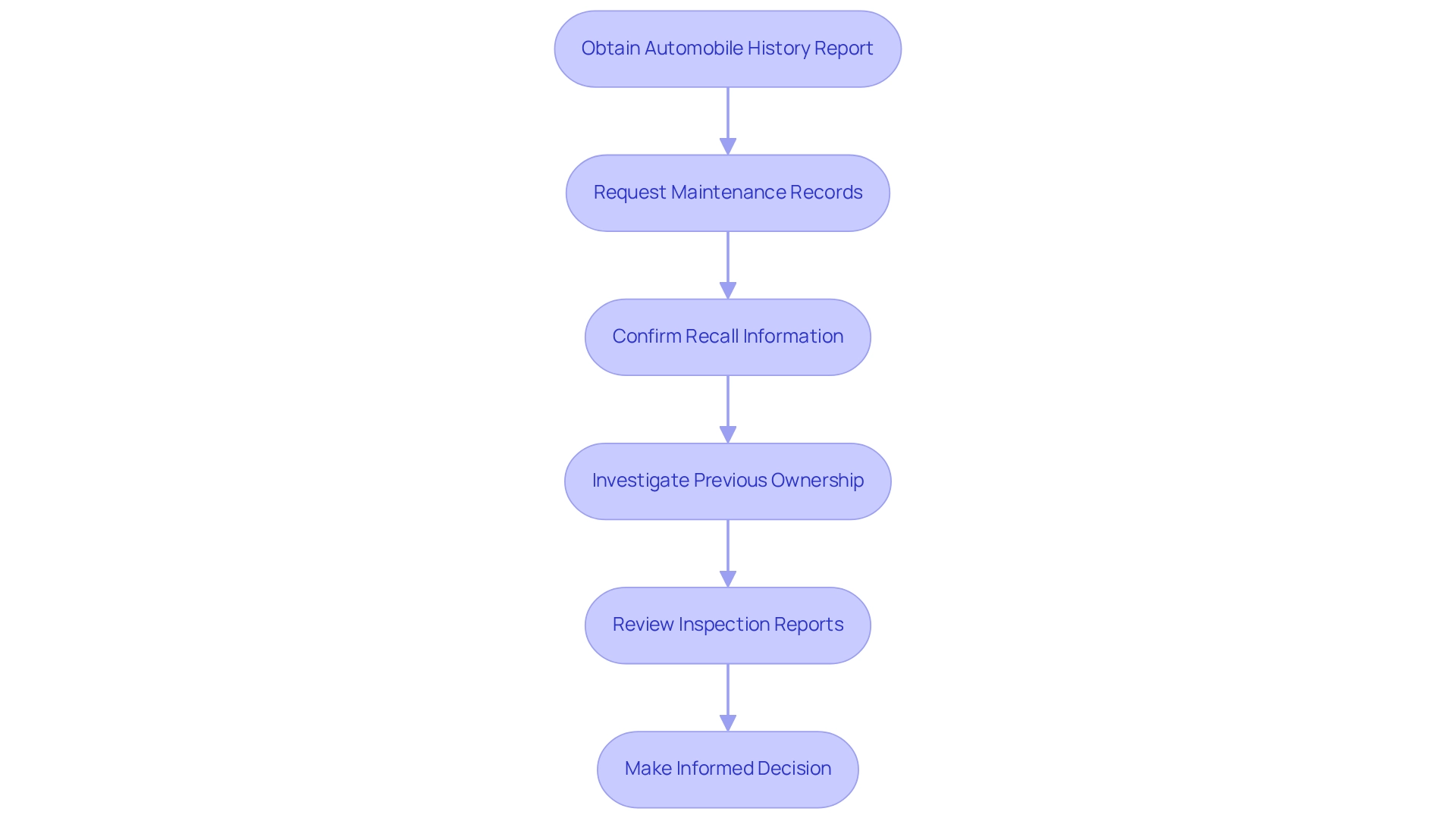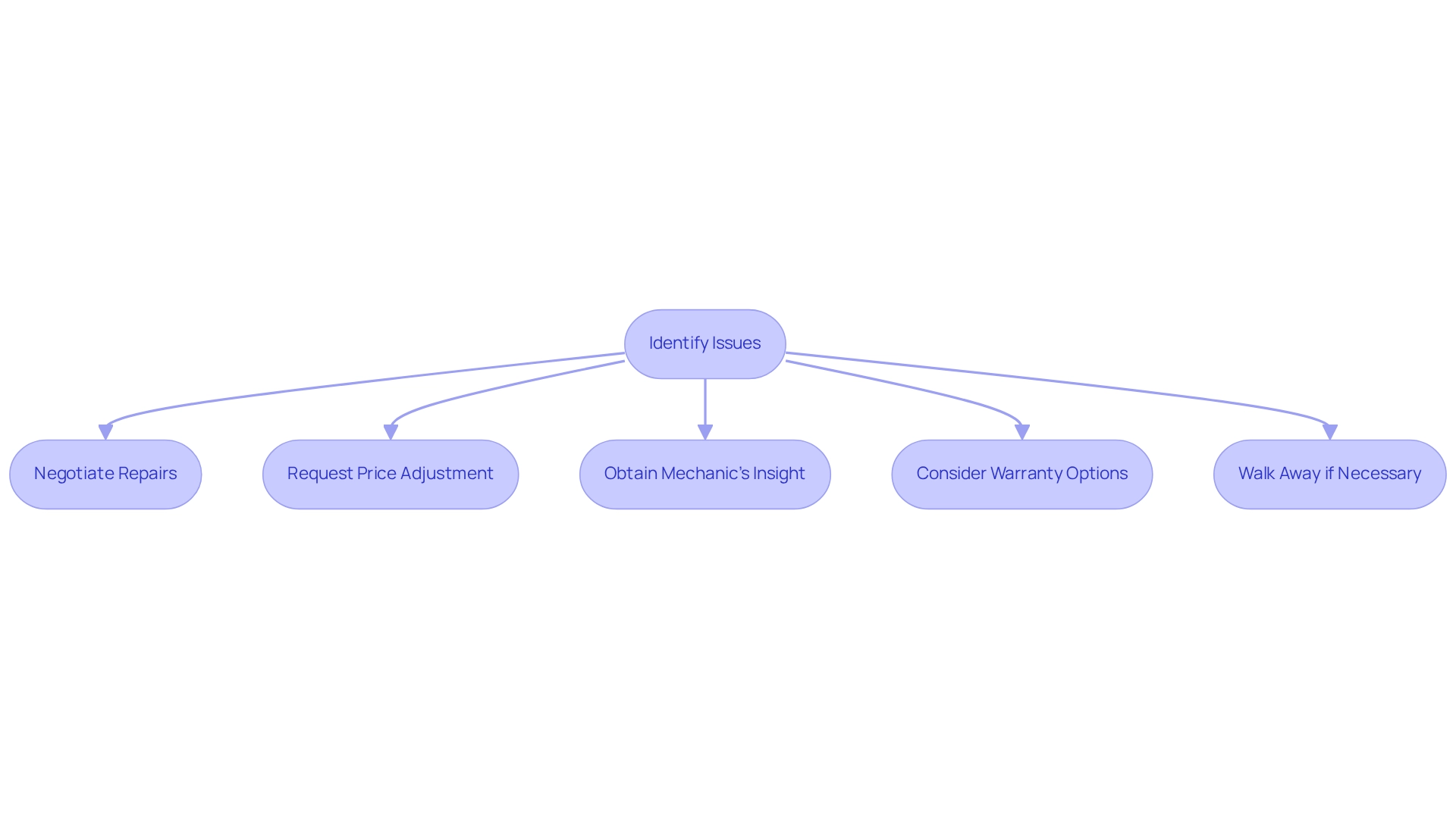4 Steps to Identify 2013 Ford Escape Known Issues Before Buying

Overview
To identify known issues with the 2013 Ford Escape before buying, prospective buyers should focus on common problems such as:
- Engine misfires
- Transmission failures
- Electrical malfunctions
Additionally, reviewing vehicle history and maintenance records is crucial. This article outlines specific areas to inspect and emphasizes the importance of addressing any identified issues. By negotiating repairs or considering these factors, buyers can ensure a sound investment.
Introduction
Navigating the used car market can be daunting, particularly when considering a vehicle like the 2013 Ford Escape, which has attracted attention due to a variety of common issues. Prospective buyers should be aware of features such as:
- Engine misfires
- Transmission troubles
As these can lead to costly surprises down the road. This article explores the key concerns surrounding this model, offering insights on how to:
- Inspect critical areas
- Review vehicle history
- Negotiate effectively with sellers
By equipping themselves with knowledge, buyers can make informed decisions, ultimately leading to a more satisfying ownership experience.
Understand Common Issues with the 2013 Ford Escape
The 2013 Ford Escape presents several common issues that prospective buyers should consider:
- Engine Problems: Owners frequently report engine misfires and excessive oil consumption, particularly in models with the 1.6L EcoBoost engine. It is crucial to listen for unusual noises or warning lights during a test drive, as these may indicate underlying issues. Notably, Ford and Lincoln brands ranked below average in J.D. Power and Associates’ 2012 Initial Quality Study, which may reflect broader quality concerns.
- Transmission Issues: Transmission failures are a significant concern, especially in higher-mileage vehicles. Be vigilant for signs of slipping or rough shifting, which can signal substantial problems.
- Electrical Problems: The electrical system has been known to malfunction, with occurrences such as non-functioning power windows and door locks being common. Ensure that all electrical components operate smoothly before finalizing a purchase.
- Exterior Door Handle Malfunctions: Many users have reported that the exterior door handles can stick or fail to return to their original position. Inspect these handles for proper functionality to avoid future inconveniences.
- Recalls: It is essential to check for any outstanding recalls, particularly those concerning the restraint control module and potential engine fires. This information can be verified through the National Highway Traffic Safety Administration (NHTSA) website.
Considering the 2013 Ford Escape known issues, Marcey Zwiebel, a representative for the automaker, stated, ‘We are obviously taking very quick action in the interest of our customers’ safety,’ which indicates the company’s commitment to addressing these concerns. Specialists observe that quality issues are frequent when car manufacturers launch numerous new models at once, and they anticipate that the company will address these challenges gradually. The expectation is that the company will enhance its quality as it tackles the issues, but the immediate effect on consumer perception remains a concern.
Being aware of these typical problems will enable you to better assess the state of a pre-owned 2013 vehicle, allowing for more effective discussions regarding repairs or price modifications.

Inspect Key Areas for Known Problems
When inspecting a used 2013 Ford Escape, it’s essential to prioritize specific key areas to uncover the 2013 Ford Escape known issues.
-
Engine Compartment: Begin by examining the engine compartment for signs of leaks, corrosion, or worn belts and hoses. It’s also crucial to check the oil level and condition; dark, gritty oil may indicate neglect.
-
Transmission Fluid: Next, inspect the transmission fluid for color and smell. It should appear as a clear red and be free of any burnt odor. If the fluid is dark or brown, this could signal underlying problems.
-
Brakes: Moving on, examine the brake pads and rotors for wear. During a test drive, listen carefully for any grinding noises, which may indicate the need for immediate replacement.
-
Suspension: Pay attention to any unusual noises when driving over bumps, as these could suggest worn suspension components. Additionally, check for rust or damage on the undercarriage to ensure safety.
-
Tires: Inspect the tires for even wear and adequate tread depth. Uneven wear may suggest alignment concerns or suspension difficulties that could affect performance.
-
Interior Electronics: It’s also vital to test all electronic features, including the infotainment system, air conditioning, and power accessories, ensuring everything functions as expected for a comfortable driving experience.
-
Cargo Space: Lastly, consider the cargo area and adaptability of the 2013 vehicle, which is practical for families needing to transport larger items. The 60/40-split folding rear seats enhance its functionality, making it a versatile option.
By thoroughly examining these areas, including the 2013 Ford Escape known issues, you can identify potential problems that may warrant negotiation or repairs before finalizing your purchase. Notably, among the 2013 Ford Escape known issues is criticism for its inexpensive-looking interior, with some owners referring to it as a ‘hunk of metal.’ One former owner even remarked, “Don’t buy this car unless you’re a masochist who enjoys suffering.” Additionally, the risk of rollover for this model stands at 19.1%, making it crucial to assess its overall condition carefully.

Review Vehicle History and Maintenance Records
Before purchasing a used 2013 Ford Escape, it is crucial to obtain and review information about the 2013 Ford Escape known issues to ensure a sound investment:
- Automobile History Report: Utilize services such as Carfax or AutoCheck to acquire a comprehensive history of the automobile. This report should emphasize any accidents, title concerns, or odometer discrepancies, which are crucial for evaluating the automobile’s history. Statistics indicate that automobiles with a clean history report are significantly less likely to have hidden issues, making this step essential for budget-conscious shoppers.
- Maintenance Records: Request maintenance records from the seller. Regular oil changes, transmission services, and brake inspections are strong indicators of a well-maintained automobile, which can significantly impact its longevity and performance.
- Recall Information: Confirm that all recalls have been addressed. This can be verified through the NHTSA website or by contacting a Ford dealer. Addressing recalls is essential for ensuring the safety and reliability of the automobile.
- Previous Ownership: Investigate the number of previous owners. Generally, fewer owners suggest better care and maintenance, which can lead to a more reliable vehicle.
- Inspection Reports: If available, review any pre-purchase inspection reports conducted by a mechanic. These reports can offer valuable insights into the condition of the automobile and highlight any necessary repairs. Additionally, understanding total loss history is crucial. Knowing if an automobile has been deemed a total loss helps consumers avoid acquiring a possibly unsafe car. This knowledge is essential for steering clear of unsafe purchases related to the 2013 Ford Escape known issues, ensuring better safety and value in vehicle investments. Thoroughly reviewing these documents not only helps in understanding the vehicle’s history but also empowers you to make a more informed purchasing decision, ultimately enhancing your safety and value in the vehicle.

Address Identified Issues Before Purchase
When examining a pre-owned 2013 Ford Escape, it is essential to efficiently address any 2013 Ford Escape known issues that may be discovered. Here are steps to guide your negotiation process:
- Negotiate Repairs: If you find minor problems, such as electrical faults or worn brake pads, discuss with the seller to have these fixed before concluding the sale. This proactive approach can save you from incurring additional costs later.
- Price Adjustment: Should the seller refuse to make necessary repairs, request a price reduction that reflects the estimated repair costs. Research average repair expenses for common issues—such as electrical system repairs, which can average around $300, or brake pad replacements, typically costing between $150 and $300—to strengthen your negotiation position.
- Obtain a Mechanic’s Insight: If you’re unsure about the seriousness of any concerns, consider having a reliable mechanic conduct a thorough examination. Their expertise can provide clarity on the automobile’s condition and help you make an informed choice.
- Consider Warranty Options: When purchasing from a dealer, inquire about available warranties or service contracts that could cover future repairs. Comprehensive coverage protects against non-collision damage such as theft or vandalism, offering peace of mind and safeguarding your investment against unexpected costs.
- Walk Away if Necessary: If the issues are significant or the seller is uncooperative, be prepared to walk away from the deal. As Consumer Protection Lawyer Eddie Esquire states, “If they don’t budge, an automobile without these immediate repair needs might prove more cost-effective than negotiating further on this one.” There are numerous other vehicles on the market, and it’s vital to find one that meets your needs without hidden problems.
By proactively addressing the 2013 Ford Escape known issues, you can ensure that your purchase is a sound investment.

Conclusion
Navigating the used car market, especially with the 2013 Ford Escape, necessitates careful consideration of common issues that may impact ownership. Key concerns include:
- Engine misfires
- Transmission problems
- Electrical malfunctions
- The importance of addressing recalls
By being aware of these potential pitfalls, prospective buyers can better assess the vehicle’s condition and negotiate effectively with sellers.
Thorough inspections of critical areas such as:
- The engine compartment
- Transmission fluid
- Brakes
- Electrical systems
are essential. Additionally, reviewing the vehicle’s history and maintenance records can provide invaluable insights into its past, ensuring a more informed purchase decision. Addressing any identified issues before finalizing the purchase—whether through repairs or price adjustments—can lead to a significantly improved ownership experience.
Ultimately, being equipped with knowledge and taking proactive steps can make a substantial difference in navigating the complexities of buying a used vehicle. With careful diligence, buyers can secure a 2013 Ford Escape that meets their needs and expectations, avoiding costly surprises and enhancing their overall satisfaction with the purchase.
Frequently Asked Questions
What are the common engine problems reported for the 2013 Ford Escape?
Owners frequently report engine misfires and excessive oil consumption, particularly in models with the 1.6L EcoBoost engine. It’s important to listen for unusual noises or warning lights during a test drive, as these may indicate underlying issues.
What transmission issues should I be aware of in the 2013 Ford Escape?
Transmission failures are a significant concern, especially in higher-mileage vehicles. Signs of slipping or rough shifting can indicate substantial problems.
Are there any electrical problems associated with the 2013 Ford Escape?
Yes, the electrical system has been known to malfunction, with common issues including non-functioning power windows and door locks. Ensure that all electrical components operate smoothly before finalizing a purchase.
What issues have been reported with the exterior door handles of the 2013 Ford Escape?
Many users have reported that the exterior door handles can stick or fail to return to their original position. It’s advisable to inspect these handles for proper functionality.
How can I check for recalls on the 2013 Ford Escape?
It is essential to check for any outstanding recalls, particularly those concerning the restraint control module and potential engine fires. This information can be verified through the National Highway Traffic Safety Administration (NHTSA) website.
What is Ford’s response to the issues with the 2013 Ford Escape?
Marcey Zwiebel, a representative for Ford, stated that the company is taking quick action in the interest of customer safety, indicating a commitment to addressing these concerns.
Why might quality issues be common in the 2013 Ford Escape?
Specialists observe that quality issues are frequent when car manufacturers launch numerous new models at once, and it is anticipated that the company will address these challenges gradually.
How can being aware of these issues help me when considering a pre-owned 2013 Ford Escape?
Being aware of these typical problems will enable you to better assess the state of a pre-owned vehicle, allowing for more effective discussions regarding repairs or price modifications.





